
Excursions in Physics
PHY 3050
Fourth Hour Exam
December 11, 2002
For every question, also consider as a possible answer
E) none of the above
1. Light
A) is an electromagnetic wave
B) is a transverse wave
C) has a wavelength between 400 nm and 700 nm
D) all of the above
2. Light
A) is an electromagnetic wave.
B) is a longitudinal wave.
C) requires a medium to be transmitted -- much like sound.
D) all of the above
3. The speed of light
A) was too fast for Galileo to measure
B) was not accurately measured or explained by Newton
C) was very accurately measured by A A Michelson
D) all of the above
4. The speed of light
A) was too slow for Galileo to measure
B) was measured by Ole Romer using astronomical data
C) was measured by A A Millikin using biological data
D) all of the above
5. When you view a white light source through a diffraction grating you will
see brightly colored spectra with
A) red on the inside and violet on the outside
B) violet on the inside and red on the outside
C) yellow on the inside and green on the outside
D) yellow on the outside and green on the inside

6. When you see a rainbow, you see
A) red on the inside and violet on the outside
B) violet on the inside and red on the outside
C) yellow on the inside and green on the outside
D) yellow on the outside and green on the inside

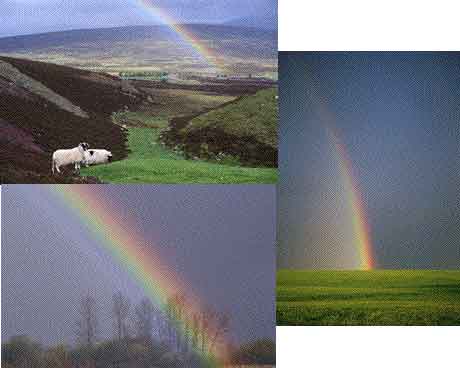
7. A single rainbow is the result of
A) one refraction and one reflection.
B) one refraction and two reflections.
C) two refractions and one reflection.
D) two refractions and two reflections.
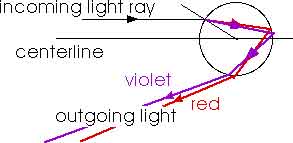
8. A double rainbow is the result of
A) one refraction and one reflection.
B) one refraction and two reflections.
C) two refractions and one reflection.
D) two refractions and two reflections.
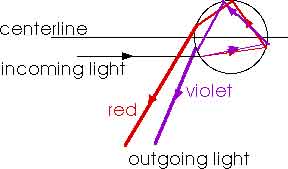
9. Rainbows are a result of
A) dispersion and reflection.
B) dispersion and polarization.
C) reconstruction and polarization.
D) constructive and destructive interference.
10. Colors in a rainbow or colors in the spectrum from a prism are there because
light of different colors travel at different speeds. This is known as
A) dissapation.
B) superposition.
C) dispersion.
D) resonance.
11. Colors seen on TV result from color
A) subtraction
B) addition
C) neither of these
D) either of these
12. Colors seen in paint result from color
A) subtraction
B) addition
C) neither of these
D) either of these
13. Look at a full-color picture in a magazine with a magnifying glass and you
will see that the inks used are
A) red, green, cyan, and blue.
B) red, green, blue, and black.
C) Cyan, Magenta, Yellow, and blacK (CYMK).
D) cyan, green, yellow, and blue.
14. A mixture of red and blue light produces
A) blue
B) magenta
C) yellow
D) cyan
15. Initially, a camera is focused at a nearby person. It is then adjusted to
focus on some far-distant mountains. To do this, the lens
A) is moved closer to the film.
B) is moved farther from the film.
C) is "opened" to larger aperature or larger opening.
D) is "shut down" to a smaller aperature or smaller opening.
16. Different colors are spread out by a prism because different colors in the
spectrum have different
A) angular momenta
B) indices of refraction
C) energies
D) momenta
17. When light passes from water into air, it is bent
A) toward the perpendicular.
B) only if it is polarized vertically.
C) only if it is polarized horizonatlly.
D) away from the perpendicular.
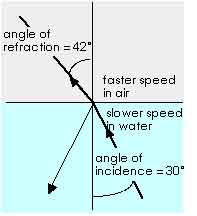
18. “index of refraction” is a description of the
A) color of light.
B) frequencyr of light.
C) speed of light.
D) all of the above
19. Light will not pass through a pair of Polaroid filters when their axes are
A) parallel
B) rotated 45°
C) rotated 57°
D) perpendicular
20. Your vision is sharpest when your pupil is
A) dilated or opened wide
B) constricted or made tiny
C) blue
D) brown
21. An object is placed 60 cm from a converging lens that has a focal length
of 20 cm. Make a ray diagram of this situation. From the ray diagram, characterize
the image.

The image is
A) real, inverted, and larger.
B) real, inverted, and smaller.
C) virtual, upright, and smaller.
D) virtual, inverted, and smaller.
22. An object is placed 40 cm from a converging lens that has a focal length
of 20 cm. Make a ray diagram of this situation. From the ray diagram, characterize
the image.
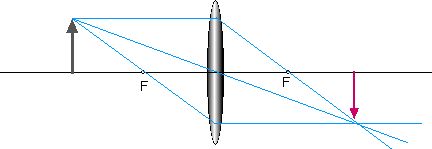
The image is
A) real and inverted (and the same size)
B) virtual, inverted, and smaller.
C) virtual, upright, and smaller.
D) virtual, inverted, and larger.
23. An object is placed 30 cm from a converging lens that has a focal length
of 20 cm. Make a ray diagram of this situation. From the ray diagram, characterize
the image.
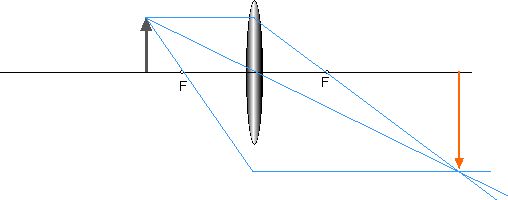
The image is
A) real, inverted, and larger.
B) real, inverted, and smaller.
C) real, upright, and smaller.
D) virtual, upright, and larger.
24. An object is placed 10 cm from a converging lens that has a focal length
of 20 cm. Make a ray diagram of this situation. From the ray diagram, characterize
the image.
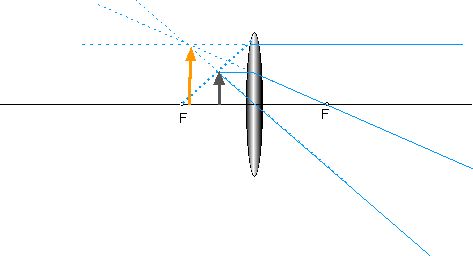
The image is
A) real, inverted, and larger.
B) real, inverted, and smaller.
C) virtual, upright, and smaller.
D) virtual, upright, and larger.
25. A simple magnifier produces
A) a virtual image between the lens and your eye
B) a real image between the lens and your eye
C) a virtual image beyond the near point of your eye
D) a real image at infinity
26. A microscope uses the front lens or objective lens to produce a
A) virtual image which is right side up.
B) virtual image at infinity.
C) real image which is then viewed through the eyepiece.
D) real image which is right side up.
27. A telescope uses the front lens or objective lens to produce a
A) virtual image which is right side up.
B) virtual image at infinity.
C) real image which is then viewed through the eyepiece.
D) real image which is right side up.
28. In the interference pattern produced by shining a laser through two slits
(Young's double slit experiment), the bright areas are the result of
A) destructive interference.
B) polarization.
C) constructive interference.
D) restructive construction.
29. A sheet of red paper will look black when illuminated with
A) red light
B) cyan light
C) yellow light
D) magenta light
30. The “near point” of a person’s eye is
A) 25 cm
B) the farthest distance at which that person can clearly see an object
C) the nearest distance at which that person can clearly
see an object
D) infinitly far away
31. The type of lenses needed to correct farsighted vision is
A) converging
B) diverging
C) convex
D) concave
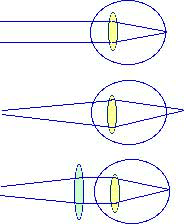
32. The type of lenses needed to correct nearsighted vision is
A) converging
B) diverging
C) convex
D) concave
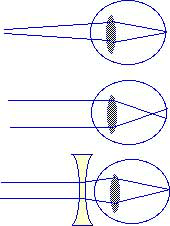
33. We see interference effects if a laser is shined at or through a double
slit (this is Young’s double slit experiment). We do not see interference
effects due to the light coming from two flashlights because their light is
A) coherent.
B) incoherent.
C) too dim.
D) too bright.
34. In an optical system with two lenses,
A) the size of the final image is the magnification of the first lens multiplied
by the object
distance of the second lens
B) the magnification of the whole system is the sum of the magnifications of
the two lenses
C) the image produced by the first lens is always virtual
D) the image produced by the first lens can be treated
as an object for the second lens
35. A double rainbow requires
A) only one reflection inside the raindrops.
B) two reflections inside the raindrops.
C) constructive interference inside the raindrops.
D) destructive interference inside the raindrops.
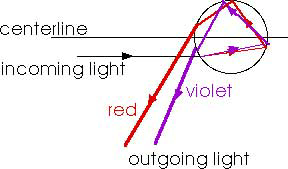
36. The critical angle for a transparent material is the angle at and
beyond which all light within the material is totally
A) absorbed
B) reflected
C) refracted
D) polarized
37. In an optical fiber, light actually
A) curves in a direction parallel to the central axis of the fiber.
B) travels in straight-line segments.
C) travels along the outer surface of the fiber.
D) all of the above.
38. Your image in a plane mirror is
A) virtual
B) real
C) both of these
39. The type of lens that spreads parallel light is a
A) converging lens
B) diverging lens
C) either of these
40. Which of the following can be projected onto a viewing screen?
A) a virtual image
B) a real image
C) a convex image
D) a concave image
41. The image of something “infinitely far away”, like the Sun, produced
by a converging lens appears
A) between the lens and the focal point
B) at the focal point
C) between the focal point and twice the focal length
D) at twice the focal length
42. According to Huygens' principle, every point on a wave
A) is a diffraction source.
B) behaves as a source of new waves.
C) is the superposition of every other part of the wave.
D) all of the above.
43. Consider plane waves incident upon a barrier with a small opening. After
passing through the opening, the waves
A) continue as plane waves
B) spread out
C) are polarized
D) converge
44.If you listen to an ambulance siren as it approaches you, you will
hear
A) a higher pitch
B) the same pitch
C) a lower pitch
D) an oscillating amplitude or loudness
compared to a stationary ambulance siren.
45. Monochromatic light is light of a single
A) color
B) wavelength
C) frequency
D) all of the above
46. Light from a laser is
A) monochromatic
B) in phase
C) coherent
D) all of the above
47. A 2-m tall person viewing his full-length image in a plane mirror
requires a mirror that is at least
A) 0.5 m
B) 1.0 m.
C) 2.0 m.
D) This depends upon how far the person is from the mirror.
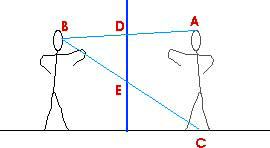
48. When two objects attempt to occupy the same space at the same time, we sa
a "collision" occurs. But waves can readily pass through each other;
this is known as
A) superchronology
B) disappation
C) disposition
D) superposition
49. When light passes through a diffraction grating it is bent. Light with a
greater wavelength will be bent
A) through a smaller angle.
B) the same (bending is independent of wavelength).
C) through a larger angle.
50. Consider two Polaroid filters crossed or rotated 90° so that no light
passes through both of them.
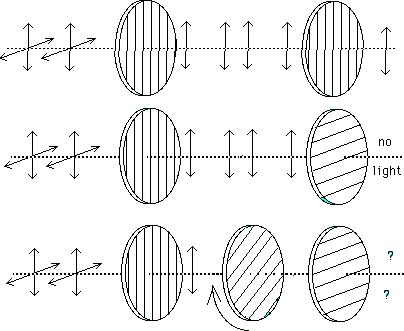
Now place a third Polaroid filter between these two. As this third Polaroid filter is rotated a complete 360°, how many times does the light coming out of this entire arrangement of three Polaroid filters go from dark to light?
A) none; it remains dark.
B) two.
C) four.
D) eight.
PHY 3050C — Fourth Hour Exam, 12/11/02